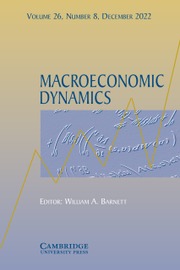No CrossRef data available.
Article contents
Unconventional policy instruments in the New Keynesian model
Published online by Cambridge University Press: 17 January 2024
Abstract
This paper analyzes the use of unconventional policy instruments in New Keynesian setups in which the “divine coincidence” breaks down. The paper discusses the role of a second instrument that, in addition to the effect of conventional interest rate policy, may enter the Phillips curve, the investment–saving (IS) curve, and the welfare function, thus influencing inflation and output. The paper presents theoretical results on equilibrium determinacy, the inflation bias, the stabilization bias, and the optimal central banker’s preferences when both instruments are available. We show that the use of an unconventional instrument reduces the zone of equilibrium indeterminacy and may reduce the volatility of the economy. However, in some circumstances, committing to not use the second instrument may be welfare-improving (a result akin to Rogoff (Journal of International Economics 18(3-4), 199–217, 1985) example of counterproductive coordination). We also show that the optimal central banker should be both aggressive against inflation and interventionist in using the unconventional policy instrument, and we analyze the optimal central banker’s preferences when social preferences would yield equilibrium indeterminacy.
- Type
- Articles
- Information
- Copyright
- © International Monetary Fund, 2024. Published by Cambridge University Press
Footnotes
We are grateful for comments and suggestions from Gianluca Benigno, Olivier Blanchard, Nicolas Coeurdacier, Emmanuel Farhi, Giancarlo Corsetti, Philippe Martin, Helene Rey, Lars Svensson, Felipe Zanna, and two anonymous referees. The views expressed in this paper are those of the authors solely and do not reflect those of the IMF or IMF policy.


